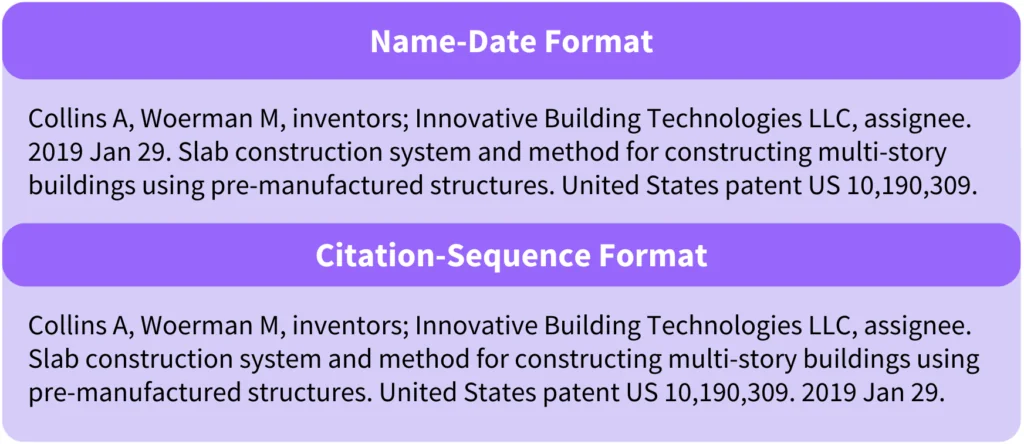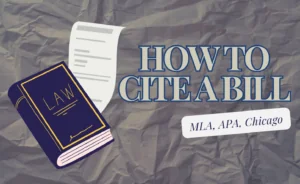Your research may touch upon various topics. Therefore, no wonder that in some cases, you might need to talk about recent (or not so) inventions in your field. When this happens, you need to make sure to include a relevant patent for these creations. This should be done both in the form of an in-text citation and as a reference entry. Now, you need to know that the most suitable style that can be used for such a source is APA, however, since you are most likely to add patents for inventions in technological fields, you can also use ACS, CSE, Chicago, and MLA. These are going to be the formats discussed in the article below.

✅ AI Essay Writer ✅ AI Detector ✅ Plagchecker ✅ Paraphraser
✅ Summarizer ✅ Citation Generator
Which Details You Need To Collect Before Citing
Before citing a patent in any academic or professional document, you need to gather specific details so that your citation is complete and allows others to locate the patent easily. The essential elements to collect for a patent citation, regardless of the formatting style, include:
- Patent Number: This is the unique identifier for the patent allowing anyone to properly locate it.
- Title of the Patent: Provides a brief overview of what the patent covers and helps differentiate it from others in related fields.
- Inventor(s): The name(s) of the inventor(s) or applicant(s) who are officially recognized as the creators of the invention.
- Country of Issue: Indicates the national patent office that issued the patent, such as the United States Patent and Trademark Office (USPTO), Canadian Intellectual Property Office (CIPO), or the World Intellectual Property Organization (WIPO).
- Issuance Year: The year when the patent was officially issued, which is needed for understanding the timeline of invention and its relevancy.
- Patent Stage: Whether the document is a granted patent or a patent application, this status indicates the maturity and legal standing of the invention.
- Source of the Patent: Always cite the primary source where the patent was found, typically the official patent office. If the patent was discovered through a secondary source like a book or a database, this should also be noted to maintain the integrity of the citation.
How to Find Information About a Patent
You might think to yourself “Where should I find all of this info in the first place?” Even though this task may seem daunting, with the right resources, it can actually be pretty straightforward. Start your search by heading to some of the most accessible online databases. Google Patents is a user-friendly option that allows you to search through millions of patents from various countries. Simply type in relevant keywords, and you’ll pull up a list of patents related to your topic. Another helpful resource is the United States Patent and Trademark Office (USPTO) website, which provides detailed searches of U.S. patents.
Once you’ve found a potential patent, you need to take the key details needed fro your citations. Make sure to note the patent number and the title of the invention, as these are crucial for any citation. Don’t forget to jot down the inventor’s name(s), the country where the patent was issued, and the year of issuance. Check whether what you’re looking at is a patent application or a granted patent, as this will influence how you cite it. If you’re pulling information from a secondary source, remember to document this as well, since it’s important to show where you actually found the patent.
Using these tools and tips, you should be able to gather all the necessary information for a complete and accurate patent citation. Remember, the goal is to make it easy for anyone reading your work to find the patents you’ve discussed, so thoroughness is key.
Citing a Patent in Different Formats
Now that you have all the details about the patent on the needed invention, we can move on to looking at more detailed rules on proper citation formatting. Note, that we will include both in-text citations and reference entry requirements to make the process easier for you. And for those students who don’t feel like arranging all the patents themselves, we have a quick and efficient solution.
We offer a fast solution for all your citation problems: Legal Citation Generator, which will generate appropriately formatted citations for you.
Patent in APA
In APA, an in-text citation for a patent includes the inventor’s last name and the year of issuance. If the patent lists multiple inventors, include the first inventor’s name followed by “et al.” for brevity in narrative citations.
For example: (Small et al., 2022).
As to the reference entry, here the rules are more detailed”
- Inventor(s): List each inventor’s last name followed by their initials, separated by commas, and use an ampersand (&) before the final inventor’s name.
- Year of Issuance: Place the year in parentheses right after the inventor’s name.
- Title of the Patent: Italicize the title and use sentence case.
- Patent Number: In a standardized format.
- Issuing Body: Name the issuing body, such as the U.S. Patent and Trademark Office.
- URL: Provide a URL where the patent can be accessed if available.

Citing Patents in ACS
If you use ACS, you should know that in-text citations for patents are typically numerical and appear as superscript numbers or in brackets, corresponding to the citation’s appearance in the reference list. For example:
Narrative citation: According to King et al.,1…
Parenthetical citation: (1)
The reference list entry for a patent in ACS should include the following elements:
- Inventor(s): List each inventor in the order they appear on the patent. Use the inverted form: Surname, Initials., separated by semicolons.
- Title of the Patent: Provide the full title of the patent followed by a period.
- Patent Number: Include the full patent number, preceded by the country code and followed by the kind code if available.
- Date: List the date of publication or the patent date.

Using CSE to Cite a Patent
When using the Council of Science Editors (CSE) citation style to cite a patent, you can choose between the Name-Date format and the Citation-Sequence or Citation-Name format. Here’s how you can format patent citations in each style, focusing on specificity and clarity required by the CSE guidelines.
Name-Date Format: This format starts with the inventor’s names, followed by the assignee (patent holder), the publication date, the title of the patent, the country of issue, and the patent number. The date is placed immediately after the assignee and is written in the format YYYY MMM DD.
Citation-Sequence and Citation-Name Format: In this format, the date appears at the end of the citation. The citation starts with the inventor’s names, followed by the assignee, the title of the patent, and then the patent number. The publication date is listed last.
For both formats, inventor names are listed in inverted form (surname first, followed by initials) without periods and without spaces between initials. The title of the patent should be in sentence case. Here are the examples for both of them.

MLA Format for Patents
MLA is widely accepted formatting style for research papers. And in case your professor asked you to use it, here are the rules you have to know.
For MLA, the in-text citation includes the inventor’s last name and the patent number, if there are multiple inventors, include the first inventor’s last name followed by “et al.”
For example: (Brun et al. EP1675021A2)
The rules for formatting references are the following:
- Inventor(s): List each inventor’s full first name and last name in inverted order. If there are multiple inventors, list them in the order they appear on the patent.
- Title of the Patent: The title should be in quotation marks.
- Patent Number
- Issuing Agency: The name of the patent office that issued the patent.
- Date of Issuance: Day Month Year format.
Here’s how you would format a reference for the patent using MLA style:

Referencing Your Patent in Chicago
For Chicago style, in-text citations generally follow the Author-Date format. When citing a patent, include the inventor’s last name and the year of issue within parentheses.
For instance: (Mollick 2022)
As to the bibliography, here’s how you need to approach citation formatting:
- Inventor(s): List the inventor’s full first name and last name.
- Title of the Patent: Italicize the title and capitalize most words in the title (title case).
- Patent Number: The full patent number.
- Dates: Mention both the filing and the issue date.
- Issuing Authority: This could be included if relevant, typically indicated as part of the patent number.

FAQ
Follow us on Reddit for more insights and updates.





Comments (0)
Welcome to A*Help comments!
We’re all about debate and discussion at A*Help.
We value the diverse opinions of users, so you may find points of view that you don’t agree with. And that’s cool. However, there are certain things we’re not OK with: attempts to manipulate our data in any way, for example, or the posting of discriminative, offensive, hateful, or disparaging material.